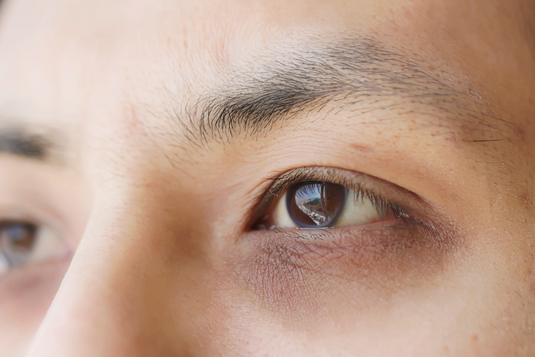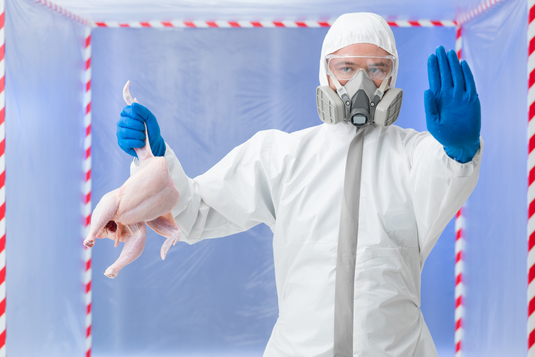If you suffer from an eating disorder, you should be reassured that you are not alone. As we've covered in the last few articles on eating disorders , almost everyone has a problem with food. You are neither different nor "abnormal" as you may have been led to feel. You simply experienced a specific combination of life events and brain and body pests. Whatever problems you've had with eating up until this point, they shouldn't define you as a person. You can overcome them and move on. To do that, you must first discover what is really going on with you.
Control
Often these food issues have an emotional side. When someone experiences upheaval—whether it's a difficult family life, a breakup or betrayal, a loss or grief—it can make them feel like they have no control over the situation that's causing them pain. For some people, this leads to attempts to control what they eat. Since they cannot stop what is happening on the outside, they can try to exert control over their body - be it by fasting, entering the so-called yo-yo pattern of bulking and purging or trying to numb emotional pain by overeating.
It can all start with someone feeling so restless that their food seems completely uninteresting. We normally have an appetite when we feel safe, calm and comfortable - and therefore experience an aversion to food when we are experiencing emotional problems, relationship turmoil, high pressure, workplace toxicity, financial problems, emotional attacks, fear, grief or when we are in conflict with siblings or other family members. During these experiences, many people may abstain from food or eat very little, feeling that they only have control over food when they have no control over anything else. Abstinence from food can become an addiction if more difficulties arise or the initial ones begin to repeat themselves. Addiction to abstaining from food is often felt as a survival mechanism, and if the cycle is not broken, it can lead to a brain-related eating disorder such as anorexia, in which a person effectively begins to starve.
On the other hand, when you don't feel safe, you often overeat. When people are under emotional stress, they may take control in the opposite direction by eating to suppress their emotions—overeating to feel calm or to dull emotions during times of confrontation, challenge, or struggle.
With these different emotional eating patterns linked to the brain, age doesn't matter. It cannot be said that one type of eating pattern appears only in the teenage years and another only in the 30s, 40s or 50s. Emotional turmoil can occur at any age. When hard times hit you, if they are not resolved for a short period, but instead continue for a long time, then a survival eating pattern can develop. If not addressed quickly enough, a survival eating pattern can turn into a life-shattering eating disorder.
Adrenaline
These survival mechanisms are connected to the brain – though not in the sense that everything is made up in someone's head or caused by their thoughts. Eating disorders do not develop because someone was simply "out of balance" or sensitive. When a severe eating disorder takes hold, dependence and addiction can follow.
Many people who try to maintain control of a prolonged emotional crisis by eating very little can experience a sense of defeat when they eat. They cannot overcome the feeling of food in themselves. When they eat, they may feel guilty, ashamed, disappointed in themselves, as if they are losing control. These feelings can lead to longer bouts of not eating, as punishment. Just looking at food can make them feel nervous, as if it's an enemy, which triggers the adrenal glands to release adrenaline. This rush of adrenaline in the body can be addictive; the sensation that adrenaline gives can feel like it takes the place of eating, which can make someone abstain from food even more and feel more in control. For some people the cycle goes like this: they try to cope by not eating, adrenaline rises at the sight of food (and is also used as a meal replacement), indulges in very small portions when eating and feels anxious or ashamed of even a few morsels passing through their mouths.
There are different varieties of eating disorders . One of them is binge eating and purging. It becomes an addiction for those who want to expel the food from their body after eating. In this case, people often eat larger portions - this is called overeating. Then, feeling like they've lost control, they try to regain control by regurgitating the food, which causes greater adrenaline rushes in the brain. Brain hype ensues. ( Other varieties of purging that are used alone or in combination with vomiting include taking laxatives or excessive exercise. These other methods of purging have the same effect—inducing an adrenaline rush. ) The adrenaline of purging can be even more addictive from the adrenaline of overeating, as purging causes greater adrenaline rushes as a defense mechanism to expel stomach contents in case something toxic, be it a pathogen or poison, has been ingested. As a result, a person can become trapped in a cycle of binge eating and purging. When we vomit, our brain must send a signal into and through the vagus nerve , reaching the stomach, prompting the stomach to prepare for an emergency evacuation. Then the vagus nerves jump out of the abdomen with an urgent impulse and at the same time send a message back to the brain to access a rush of adrenaline.
When someone is stressed and eats a lot, using food to comfort or suppress their emotions—whether the binge is followed by a purging cycle or not—there are often hidden, underlying reasons. One reason is to get an adrenaline rush. Excess adrenaline, especially when triggered by emotional pain, is harmful as it travels through the brain and body. Without realizing it, our brain will often signal us to eat carbs to compensate for this adrenaline because with carbs comes extra glucose to bind to and trap this hormone, preventing the intense adrenaline from doing damage. Adrenaline and glucose are consumed together: glucose binds to adrenaline, allowing the hormone to be eliminated through urination.
Glucose from carbohydrates also calms the nervous system, which is why people so often reach for pizza or chips to provide themselves with a small safety zone. We're not taught to reach for pure carbs. Instead, we reach for certain combinations of fats and carbohydrates, and these combined foods end up trapping adrenaline in fat cells instead of leaving the body.
If the severe stress that causes someone to overeat is short-lived, they often return to their old normal. If the emotional situation in someone's life is long-term, with very rare moments of relief, then the eating pattern will often continue.
Excess adrenaline can have a strong effect on the central nervous system. As it saturates the brain, this adrenaline can sensitize nerves, which can lead to the development of anxiety. However, eating disorders are not always just about the brain. Too much adrenaline can irritate the lining of the stomach and intestines, making them hypersensitive, almost like open wounds. Adrenaline sensitizes nerves in general, including the vagus and frenetic nerves that run to the gut, and as a result, that area around the diaphragm, stomach, and intestinal tract can become hypersensitive, whether or not food passes through it. These effects of adrenaline alone can contribute to an eating disorder, often prompting someone to not eat at all for a while or to eat too quickly – trying to soothe the unpleasant feeling by eating.
Toxic heavy metals
Some eating disorders are not caused by difficult emotional circumstances. These are cases where life goes on normally with its usual highs and lows, and seemingly out of nowhere a severe eating disorder develops. If a doctor examines you, he will not find any concussions, bullying, family problems, relationship problems, or workplace confrontations that have led to severe stress. What is really happening in these cases is that something else is affecting the brain – toxic heavy metals .
Mercury, aluminum, and copper are the predominant metals that underlie these types of eating disorders that seem to appear out of nowhere. Exposure to toxic heavy metals can accumulate in brain tissue through a variety of sources, which you read about in the article "Pests That Make Us Sick - Toxic Heavy Metals" . This leads to eating disorders at a wide range of ages – as early as childhood, teenage years, young adulthood, into the 30s, 40s or later. Toxic heavy metals in certain areas of brainstem tissue can create a sensation of lack of appetite because the metals interfere with hunger messages that are transmitted between the brainstem and stomach via the vagus nerves . Toxic heavy metals in the brain can also create momentary difficulty swallowing that makes a person not want to eat because the metals interfere with vagus nerve messages to the esophagus and throat. This causes panic for a moment and interrupts the hunger. Not eating can lead to serious conflict with a person's basic impulse to eat to survive.
If this is happening to one of their children, concerned parents are often on the alert and monitoring when their child is eating and when they are not, making it a major point of attention and concern. While this is not one of the emotional harms mentioned earlier—these are reactions out of love—parental concern or worry can still be heavy on the suffering child. Already confused as to why he has no appetite and perhaps even feels nauseous when told to eat, this can begin to create a small emotional wound around feeding for the child.
When someone struggles with an eating disorder in which they don't want to eat enough, professionals and loved ones often try to change their diet by pressuring them to increase the amount of their favorite foods such as pasta, pizza, waffles, pies or other quick foods. This can complicate the situation by causing its own emotional trauma. Young people are often subjected to additional peer and societal pressure regarding weight, and when combined with toxic heavy metal poisoning in the brain and family members demanding that they eat – and eat certain foods – anxiety may occur.
This can be the recipe for young people to start throwing up their food when they experience acute, first bouts of bulimia. If heavy metal toxicity is more severe, bulimia can develop even without family pressure. No external catalyst is required. The toxic heavy metals themselves, which are found in brain tissue in and around neurons, are both the cause and the constant trigger.
As mentioned earlier, one of the problems with bulimia is that when you throw up food (or otherwise purge), you experience a rush of adrenaline that brings you relief. When toxic heavy metals are found in the brain, they tend to inhibit electrical impulses and suppress neurotransmitters, so people who suffer from eating disorders caused by toxic heavy metals also tend to develop mild to severe problems with focus and concentration , fatigue, various types of hypersensitivity, attention deficit hyperactivity disorder (ADHD), Tourette syndrome, seizures, obsessive-compulsive disorder (OCD) , depression, tics or anxiety. When someone vomits and the adrenaline is released, it acts like a drug, creating a feeling of clarity, calm, or even euphoria. The rush of adrenaline is a temporary antidote to neurons in the brain that are saturated with toxic heavy metals. Adrenaline ignites electrical impulses, allowing them to burn more intensely without pain or discomfort, overpowering mental and physical symptoms by dulling them. Adrenaline has a complex steroid composition that can be temporarily sedating at first. Then, when it wears off, symptoms can get worse, which can make the times when we're out of adrenaline unpleasant. This causes the need for more of this complex steroid. This is why some eating disorders can feel inevitable. Those adrenaline rushes of bulimic purges are extremely addictive. It is very easy to develop a pattern that seems impossible to break.
At the same time, no one sees the real source of the problem: toxic heavy metals in the brain. Sometimes, when the brain is still developing, new growth forms around the toxic metals over time, and someone can naturally grow out of the signals that were causing the unhealthy eating patterns because the electricity that runs through the brain is redirected to the newly developed brain tissue. A person can live normally for a while and then suddenly—for example, in their 30s—symptoms develop again because the toxic heavy metals in the original brain tissue have undergone accelerated oxidation, spreading to other areas of the brain. Eventually, the oxidative leakage of toxic heavy metals can spread to the newly formed brain tissue. Additional toxic heavy metals from other exposures can also become lodged in the newly formed brain tissue. In other cases, a person develops heavy metal toxicity later in life and experiences their first bout of anorexia or bulimia or undiagnosed binge eating with intermittent purging when they are perhaps 40 years old.
In bulimia, the adrenaline addiction can still be very strong, so even if the root cause – toxic heavy metals – is gone, it can be very difficult for someone to break the purging cycle and overcome the disorder. With each eating disorder caused by toxic heavy metals, there are different combinations and different levels at which toxic metals affect a person's life. In anorexia, it is most difficult to distinguish between cases where there are toxic heavy metals in a person's brain and external sources of emotional pain.
Many people with severe eating disorders take amphetamines and other stimulants prescribed for attention deficit hyperactivity disorder (ADHD) and brain fog . These drugs also induce adrenaline, which acts as a temporary solution to heavy metal toxicity, which is one of the ways that amphetamines and other stimulants offer relief, allowing a person to function, focus, and concentrate. Meanwhile, stimulants contain toxic heavy metals that exacerbate the problem. These medications create additional wear and tear on the adrenal glands, ultimately adding new symptoms that can exacerbate the eating disorder.
Recovery: beyond crisis intervention (intervention)
When it comes to eating disorder recovery, standard medicine is built around crisis intervention. When an eating disorder is diagnosed, the recommendation is usually to eat whatever the person wants. The hope is that eating all the comfort foods you want will break the eating disorder. The psychological conditioning is: "Be happy, don't feel guilty and don't punish yourself". This is considered the best, most advanced medical technology and strategy. In fact, this is an old clinical approach, introduced half a century ago, that keeps people with similar problems stuck in one place.
Others are right when they tell you that you shouldn't feel ashamed, guilty, or hate yourself for eating your favorite foods that they themselves hope you eat. But you also shouldn't be penalized if you want to be mindful, intuitive, and caring about what you eat to benefit your body and health. Everyone changes. As you grow as a person and go through the crisis state, you will learn more about your body and health. You will discover healthier ways of eating. They shouldn't make you feel guilty for being extra careful about your choices. Worrying about what food you put in your body shouldn't be put in the "You could get your eating disorder back" column.
The old clinical strategy that is still in place is based on a lack of understanding of how eating disorders develop and how to treat these disorders. This strategy ultimately encourages people to eat foods that are far from healthy—foods that eating disorder patients may have been afraid to eat during or even before their eating disorder. ( Another strategy is to eat these foods in the company of other people. There are some good reasons for this strategy to exist—for example, to ensure that someone is actually eating, to find comfort in the shared meal. ) The industry does not report the problems that develop because of this strategy of eating all these comfort foods. One of the problems that arises is when the sufferer has a health problem that is separate from their eating disorder. If this person had not been diagnosed with an eating disorder, then nutritionists, nutritionists, and doctors would likely have recommended that the patient eat a healthier version of the standard diet or avoid processed foods. The sufferer would have been given the opportunity to maintain his health. However, dietitians, nutritionists, and physicians are often trained to avoid these healthier approaches when it comes to treating a patient with a history of an eating disorder . It's as if healthy eating is off-limits to someone with an eating disorder. Suddenly, healthy eating turns into a serious eating disorder. It is taboo.
This causes the person with an eating disorder to fall into a new trap - deterioration of health and lack of place in the diet. This deterioration of health can include diabetes , obesity, major depression, body aches, chronic fatigue , ulcers, acid reflux , irritable bowel syndrome (IBS), Crohn's disease, colitis , celiac disease, and any autoimmune diagnoses. During this eating disorder recovery process, the system does not look ahead to the person's future. The patient doesn't hear, "We need to train you to eat healthier during eating disorder recovery so you don't become chronically ill and lose all opportunities to heal with your food." Instead, those in recovery from eating disorders often feel pressured to eat the unhealthiest foods to prove to counselors, family members, and friends that they are eating, even if it hurts their physical health. People in eating disorder recovery do not feel that they are allowed the free will to explore new approaches and use foods to get healthy because this will be taken as a sign that someone in their life is signaling that their eating disorder may be come back Observers who have lost trust become suspicious.
This is one of the big misunderstandings in the eating disorder industry. This is why eating disorder recovery strategies fail time and time again. We need to enable people to thrive as they go through crisis intervention (intervention) and continue their recovery. We can't sabotage them with a new form of food shame—shame about finding a diet that works—and expect them to watch their health deteriorate while eating fried, fatty, processed foods for the rest of their lives. It should always be possible for people to change their eating habits if their health is deteriorating and they seek help. They should be allowed to change their eating habits to healthier choices, not be ridiculed, punished, or viewed as if their eating disorder has not improved.








